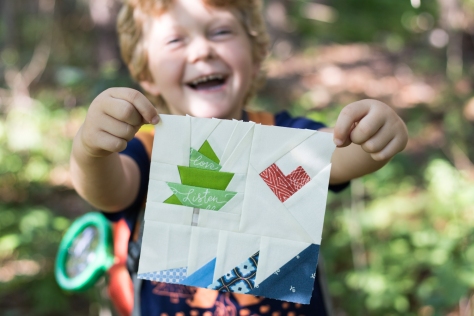 Today I’m excited to reveal the block I designed for the Splendid Sampler 2 book: Adventure Abounds, found on page 122. Those of you who know me are most likely not surprised by this block one bit! For those of you who are new, welcome! I’m Kitty Wilkin, aka Night Quilter, and I’m so glad you’re here! I am a full time mom of three kiddos in rural Maine, but I’m also a pattern designer (EPP, FPP, traditional piecing–I love it all!), quilt and product photographer, teacher, social media manager for the Quilter’s Planner, AND an avid fussy cutter, which I prefer to call meticulous cutting. I’m often inspired by the natural world around me, and when Pat and Jane asked me to design a block reflecting my best quilty life, I knew it had to include family adventures in nature tied together through the creation of a quilt. With strong influence from my Summer Adventure quilt pattern, this block has a bit of everything–sea, trees, and lots of love!
Today I’m excited to reveal the block I designed for the Splendid Sampler 2 book: Adventure Abounds, found on page 122. Those of you who know me are most likely not surprised by this block one bit! For those of you who are new, welcome! I’m Kitty Wilkin, aka Night Quilter, and I’m so glad you’re here! I am a full time mom of three kiddos in rural Maine, but I’m also a pattern designer (EPP, FPP, traditional piecing–I love it all!), quilt and product photographer, teacher, social media manager for the Quilter’s Planner, AND an avid fussy cutter, which I prefer to call meticulous cutting. I’m often inspired by the natural world around me, and when Pat and Jane asked me to design a block reflecting my best quilty life, I knew it had to include family adventures in nature tied together through the creation of a quilt. With strong influence from my Summer Adventure quilt pattern, this block has a bit of everything–sea, trees, and lots of love!
If you’re new to the Splendid Sampler books curated by Pat Sloan and Jane Davidson, find out more about the Splendid Sampler 2 book and sew along HERE.
 Today I am going to share 3 tips for using fussy cutting in foundation paper pieced blocks, using my Adventure Abounds block from the Splendid Sampler 2 book. If you’re new to foundation paper piecing (FPP), read my beginner basics FPP tutorial HERE first to make sure you know all of the key components and basic tips. Then let’s dive in!
Today I am going to share 3 tips for using fussy cutting in foundation paper pieced blocks, using my Adventure Abounds block from the Splendid Sampler 2 book. If you’re new to foundation paper piecing (FPP), read my beginner basics FPP tutorial HERE first to make sure you know all of the key components and basic tips. Then let’s dive in!
 There are a few things you should remember before beginning FPP: First, the templates are a mirror image of the finished block, so when planning your fabric placement, visualize the right side of your fabric on the back of the template. Second, I highly recommend color coding your paper templates before starting so that you know exactly where each fabric should be. Third, don’t forget to use paper scissors to cut out and trim the templates! Your fabric scissors don’t want to go there!
There are a few things you should remember before beginning FPP: First, the templates are a mirror image of the finished block, so when planning your fabric placement, visualize the right side of your fabric on the back of the template. Second, I highly recommend color coding your paper templates before starting so that you know exactly where each fabric should be. Third, don’t forget to use paper scissors to cut out and trim the templates! Your fabric scissors don’t want to go there!
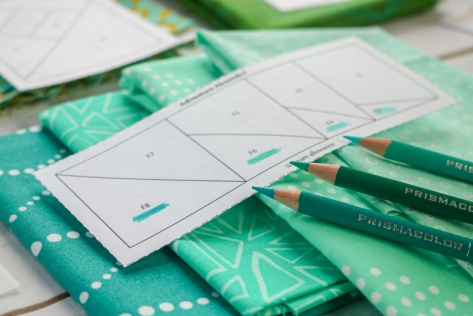 Once your fabrics are selected, your templates are cut out along the 1/4″ seam allowance line and color coded, you’re ready to dive in. Here are three tips for using fussy cutting in FPP:
Once your fabrics are selected, your templates are cut out along the 1/4″ seam allowance line and color coded, you’re ready to dive in. Here are three tips for using fussy cutting in FPP:
1. Place your fussy cut on piece 1
One of the easiest ways to use fussy cutting with FPP is to position your fussy cut fabric on the very first piece placed. With this method, simply hold your fabric up to a light source on the wrong side of the paper template, aligning the fabric motif you want to feature. Use a little dab of washable glue stick to hold it in place, and then continue piecing the rest of the block as you normally would. Your fussy cut can be perfectly positioned with very little effort. Depending on the block you’re creating, even this little use of fussy cutting can create quite an impact.
 As an example of this for my Adventure Abounds block, I decided to position a subtle bird in the sky above the ocean, and held it up to a window to make sure it was positioned exactly how I wanted it. With a white on white background for my blocks, this example is subtle, but sometimes those subtle details are my favorite!
As an example of this for my Adventure Abounds block, I decided to position a subtle bird in the sky above the ocean, and held it up to a window to make sure it was positioned exactly how I wanted it. With a white on white background for my blocks, this example is subtle, but sometimes those subtle details are my favorite!
2. Create templates
Another way to make fussy cutting a bit easier while foundation paper piecing is to create a template for the pieces you wish to meticulously cut. You can use template plastic for this, or can even repurpose clear plastic lids to food containers. You want to use something that you can see through or at least trace through using a light source.
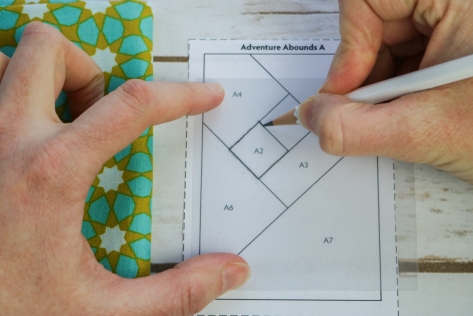 To create a template, first trace the shape from the paper foundation template onto the plastic. Be sure to label your piece, AND make note of directionality since the paper template is a mirror image.
To create a template, first trace the shape from the paper foundation template onto the plastic. Be sure to label your piece, AND make note of directionality since the paper template is a mirror image.
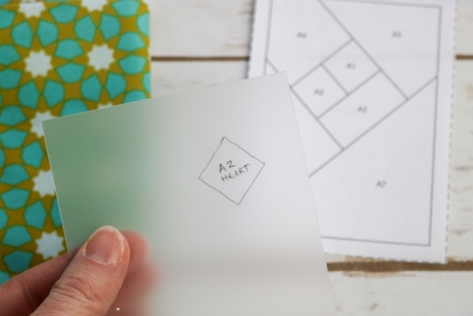 Once I trace the shape, I flip over the template plastic and write my notes on the opposite side, so that when I cut the fabric for that piece, I know that my notes should be legible on the right side of the fabric.
Once I trace the shape, I flip over the template plastic and write my notes on the opposite side, so that when I cut the fabric for that piece, I know that my notes should be legible on the right side of the fabric.
 Next, using a quilting ruler with 1/4″ measure, draw seam lines 1/4″ outside all the edges of your drawn lines.
Next, using a quilting ruler with 1/4″ measure, draw seam lines 1/4″ outside all the edges of your drawn lines.
 Cut out the template along that seam allowance line.
Cut out the template along that seam allowance line.
Repeat for all of the shapes you want to fussy cut. You can use the clear templates to be sure you’re cutting your fabric piece exactly as you want it. Note that you will want to use all of the tips outlined in this tutorial when piecing so that the perfectly cut piece of fabric gets sewn in exactly how you want it.
 For my block, I decided to fussy cut the heart so that the fabrics for the two pieces of the heart look continuous despite consisting of two fabric pieces. I decided to make a third reference template of the full heart and traced the pattern from the fabric onto the template, which I used as a reference when cutting out each individual part.
For my block, I decided to fussy cut the heart so that the fabrics for the two pieces of the heart look continuous despite consisting of two fabric pieces. I decided to make a third reference template of the full heart and traced the pattern from the fabric onto the template, which I used as a reference when cutting out each individual part.
 Once you have your template positioned over the exact motif you want, carefully trace around the template with a fabric marking tool and cut out the fabric, or very carefully use a rotary cutter to cut around the template. Note that with planning templates made with template plastic or repurposed food lids, using your rotary cutter contains a good level of danger–so either purposefully live on the wild side, or use the trace and cut-with-scissors method!
Once you have your template positioned over the exact motif you want, carefully trace around the template with a fabric marking tool and cut out the fabric, or very carefully use a rotary cutter to cut around the template. Note that with planning templates made with template plastic or repurposed food lids, using your rotary cutter contains a good level of danger–so either purposefully live on the wild side, or use the trace and cut-with-scissors method!
 Your perfectly planned fabric piece is ready to carefully stitch onto your growing foundation paper pieced section.
Your perfectly planned fabric piece is ready to carefully stitch onto your growing foundation paper pieced section.
Because this piecing is quite meticulous, you’ll want to be sure to align this next piece perfectly before stitching.

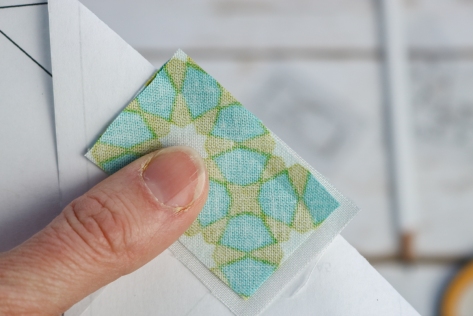 Folding along the seam on which you are about to stitch and trimming the overhanging fabric to 1/4″ will help you line up the next piece accurately.
Folding along the seam on which you are about to stitch and trimming the overhanging fabric to 1/4″ will help you line up the next piece accurately.
 You can also fold over the piece you are about to stitch along the seam line to see how it looks before actually stitching.
You can also fold over the piece you are about to stitch along the seam line to see how it looks before actually stitching.
Note that meticulous cutting is exactly that–meticulous. Be sure to be meticulous in all phases of this process to get the best results. Also, be gentle with yourself. This is not easy! Use a stitch length that you are comfortable ripping out if needed to get those first fabrics lined up. I give myself a Rule of 3 when stitching any block: I’m allowed to use my seam ripper to rip out progress and make it align better 3 times during the stitching process for any block. Once I hit my 3 times, I need to just accept the imperfections and move on. We are human, after all. But don’t be afraid to try! As with anything, the more you practice, the easier it will get.
 Once your fussy cut pieces are cut and stitched as desired, continue piecing your non-fussy cut pieces as you would any other FPP block.
Once your fussy cut pieces are cut and stitched as desired, continue piecing your non-fussy cut pieces as you would any other FPP block.
3. Focus on the joining seam
A third tool to use while fussy cutting in FPP is to pay close attention to the edge of the motif you want to feature. This works particularly well for lining up directional prints along the seam line, or for less precise fussy cuts.
This method is used for any piece AFTER the first piece placed. If your fussy cut is the first piece, use Tip 1!
 In the Adventure Abounds block I made for the original Splendid Sampler 2 quilt, I used this tip when piecing the text on the tree, specifically the word “love”, since the word “listen” was the first piece placed, and was therefore easy to simply glue in place and piece around. Knowing that I wanted the top of the word love to be juuust below that darker top piece, when I cut the square of fabric I carefully cut just a tad bit more than 1/4″ from that top edge of the word love. I left the rest of the rectangle of fabric a bit larger and less specific, since as long as that edge lined up properly, the rest didn’t matter.
In the Adventure Abounds block I made for the original Splendid Sampler 2 quilt, I used this tip when piecing the text on the tree, specifically the word “love”, since the word “listen” was the first piece placed, and was therefore easy to simply glue in place and piece around. Knowing that I wanted the top of the word love to be juuust below that darker top piece, when I cut the square of fabric I carefully cut just a tad bit more than 1/4″ from that top edge of the word love. I left the rest of the rectangle of fabric a bit larger and less specific, since as long as that edge lined up properly, the rest didn’t matter.
With the Adventure Abounds block I’m making for my own Splendid Sampler 2 quilt, I am not using as finicky or directional of fabric for the tree, so there is no need for fussy cutting. However, I wanted to control the directionality of the fabric in a few of the waves, so that the dots on the Cotton and Steel basics and the wavy paths on the bike path fabric by Alison Glass ran parallel to the seam line. The piece is not the first one placed, so I couldn’t use Tip 1. All I want to control is the directionality of the fabric, so making a template seems like more work than is necessary. Enter Tip 3: Focus on the joining seam.
 Whenever employing any type of meticulous cutting in your FPP, it’s always a good idea to trim your 1/4″ seam allowance before positioning and stitching your fussy cut shape. To do this, simply fold back the foundation paper along the line you are about to sew on, and using a quilting ruler with 1/4″ measure, trim the fabric 1/4″ away from the fold. (Obviously use a cutting mat underneath! This photo shows without the mat for aesthetic consistency). Once your fabric is trimmed, you have a clean line with which to line up your next meticulously placed piece.
Whenever employing any type of meticulous cutting in your FPP, it’s always a good idea to trim your 1/4″ seam allowance before positioning and stitching your fussy cut shape. To do this, simply fold back the foundation paper along the line you are about to sew on, and using a quilting ruler with 1/4″ measure, trim the fabric 1/4″ away from the fold. (Obviously use a cutting mat underneath! This photo shows without the mat for aesthetic consistency). Once your fabric is trimmed, you have a clean line with which to line up your next meticulously placed piece.
This also helps facilitate another key FPP tip, which I originally learned from Lee Heinrich of Freshly Pieced, and which has saved me countless brain-scruntches trying to be sure a fabric piece would align properly on wonky angles in FPP.
 When your paper is folded along the seam-to-be-sewn, you can place it on your next fabric (right side up) and the paper shape as folded will be exactly on top of the fabric that will end up in that space once you sew along the line. Be sure to visit Lee’s tutorial for a perfectly clear and in depth explanation–it’s truly life changing when it comes to FPP!
When your paper is folded along the seam-to-be-sewn, you can place it on your next fabric (right side up) and the paper shape as folded will be exactly on top of the fabric that will end up in that space once you sew along the line. Be sure to visit Lee’s tutorial for a perfectly clear and in depth explanation–it’s truly life changing when it comes to FPP!
 What that means for us is that with that clear 1/4″ seam line showing us the direction we want our print to go, simply lining up the folded seam line with the directional print will ensure the pattern runs in exactly the direction we want. Fold up the edge a bit to peek under and make sure the pattern is positioned the way you want it, then without changing the position of the fabric, fold the paper back up and sew along the line.
What that means for us is that with that clear 1/4″ seam line showing us the direction we want our print to go, simply lining up the folded seam line with the directional print will ensure the pattern runs in exactly the direction we want. Fold up the edge a bit to peek under and make sure the pattern is positioned the way you want it, then without changing the position of the fabric, fold the paper back up and sew along the line.
 You will end up with your directional fabric meticulously positioned along the seam line, just how you wanted it. Paired with that fun bird flying over the ocean that we placed using Tip 1, these tips can help take your foundation paper piecing blocks to a whole new, intentional level.
You will end up with your directional fabric meticulously positioned along the seam line, just how you wanted it. Paired with that fun bird flying over the ocean that we placed using Tip 1, these tips can help take your foundation paper piecing blocks to a whole new, intentional level.
 Here’s the block I made for my slowly growing Splendid Sampler 2 quilt, about which I’ll show you more soon! I’m creating monochromatic blocks and using an alternate rainbow layout I sketched out in my Quilter’s Planner. This Adventure Abounds block will be positioned in the teal row, but as you can see, it is transitioning to the green. I made a compromise from my monochromatic-rule for this block, since I make the rules around here anyway! ha!
Here’s the block I made for my slowly growing Splendid Sampler 2 quilt, about which I’ll show you more soon! I’m creating monochromatic blocks and using an alternate rainbow layout I sketched out in my Quilter’s Planner. This Adventure Abounds block will be positioned in the teal row, but as you can see, it is transitioning to the green. I made a compromise from my monochromatic-rule for this block, since I make the rules around here anyway! ha!
 Okay, just one peek at my planned layout and a few of my blocks so far. A full look will come in its own blog post soon, so be sure to follow this space!
Okay, just one peek at my planned layout and a few of my blocks so far. A full look will come in its own blog post soon, so be sure to follow this space!
Thank you so much for joining me today–I hope this tutorial is helpful and entices some new fussy cutters to try adding some meticulous cutting to their foundation paper piecing! Please show me what you’re making and either comment with a photo, or tag me on social media @nightquilter . Most of all, have fun!!
If you’re sewing along with the Splendid Sampler 2 excitement, be sure to head over to the Splendid Sampler website, and post your completed Adventure Abounds block. There is a fun Martingale book giveaway for one lucky person picked from the blocks shared on their website.
 Have fun with your Adventure Abounds block, and may your adventures abound!
Have fun with your Adventure Abounds block, and may your adventures abound!
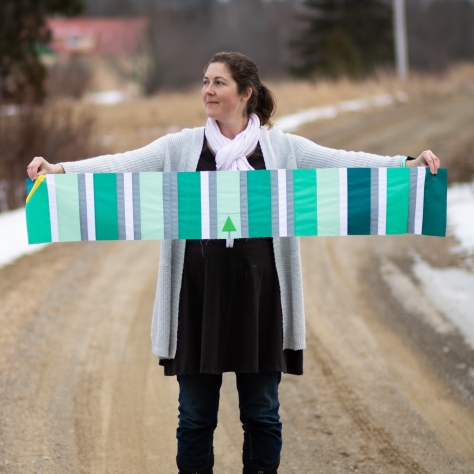 I kicked off the year with a 5K race and a personal record (PR) of 26:28.9 (woohoo!), snuck a hike in there in the middle, managed one back-to-back run duo, and finally started adding some longer runs with a 6 miler and 5 miler toward the end there. To read more details on how I plan to make this quilt, what each strip and color represent, and why some strips are skinnier than others, check out my first post My 2020 Miles Quilt here.
I kicked off the year with a 5K race and a personal record (PR) of 26:28.9 (woohoo!), snuck a hike in there in the middle, managed one back-to-back run duo, and finally started adding some longer runs with a 6 miler and 5 miler toward the end there. To read more details on how I plan to make this quilt, what each strip and color represent, and why some strips are skinnier than others, check out my first post My 2020 Miles Quilt here. I love the way the tree looks in there to represent our 2 mile snowy hike, and can’t wait until summer when hikes are much more frequently scattered throughout this quilt!
I love the way the tree looks in there to represent our 2 mile snowy hike, and can’t wait until summer when hikes are much more frequently scattered throughout this quilt! Here’s a peek at the tracking from earlier in the month, before I changed my width to 70″. I’m getting close to the end of the first row at this point, as well as close to 50 miles, when I’ll stitch a little 3″ runner from my Run Run Run pattern into the strip to designate the completion of 50 miles. I’m actually only 7 miles away from 50 miles as of this morning, so I’m plotting out a 7 mile long run for tomorrow so that my little runner will be in a purple color, too! We’ll see if I can motivate myself to get out in the 27 degree forecasted cold for a long run, or whether I split it up over tomorrow and Friday and accept a teal runner marker.
Here’s a peek at the tracking from earlier in the month, before I changed my width to 70″. I’m getting close to the end of the first row at this point, as well as close to 50 miles, when I’ll stitch a little 3″ runner from my Run Run Run pattern into the strip to designate the completion of 50 miles. I’m actually only 7 miles away from 50 miles as of this morning, so I’m plotting out a 7 mile long run for tomorrow so that my little runner will be in a purple color, too! We’ll see if I can motivate myself to get out in the 27 degree forecasted cold for a long run, or whether I split it up over tomorrow and Friday and accept a teal runner marker. This quilt has definitely motivated me to get out there and run on even the coldest days, with most of the runs logged here in Maine, where I crunch along on frozen ground, sometimes snow and ice, and always with lots of layers.
This quilt has definitely motivated me to get out there and run on even the coldest days, with most of the runs logged here in Maine, where I crunch along on frozen ground, sometimes snow and ice, and always with lots of layers. It’s pretty even if it’s frigid.
It’s pretty even if it’s frigid. Yesterday I took a bit of time to cut strips for miles 2 through 9, as well as a bunch of cross training and rest day strips. Now I’m ready to go, set up for success for February, since all I’ll need to do is get out there and run, then grab the coinciding strip to add to my design wall. Here’s to a fit and fabulous (and maybe a bit brighter) February!
Yesterday I took a bit of time to cut strips for miles 2 through 9, as well as a bunch of cross training and rest day strips. Now I’m ready to go, set up for success for February, since all I’ll need to do is get out there and run, then grab the coinciding strip to add to my design wall. Here’s to a fit and fabulous (and maybe a bit brighter) February! Speaking of pink, I’m having my annual Spread the Love Pattern sale now through February 14th, so be sure to use code LOVE2020 at my Payhip shop for 20% off! Stock up on Night Quilter patterns now, and spread the love!
Speaking of pink, I’m having my annual Spread the Love Pattern sale now through February 14th, so be sure to use code LOVE2020 at my Payhip shop for 20% off! Stock up on Night Quilter patterns now, and spread the love!


 I recently faced the demon that was my chaotic sewing space and have been organizing with the help of my dear friend Alessandra. Yesterday when I shared the above photo of my newly cleared cutting table on Instagram, there were many questions about my rainbow of skinny bins hanging along the side of it. My skinny bins were made using a tutorial I wrote for Quilt Theory years ago, for a fabulous fabric party hosted by
I recently faced the demon that was my chaotic sewing space and have been organizing with the help of my dear friend Alessandra. Yesterday when I shared the above photo of my newly cleared cutting table on Instagram, there were many questions about my rainbow of skinny bins hanging along the side of it. My skinny bins were made using a tutorial I wrote for Quilt Theory years ago, for a fabulous fabric party hosted by  A few weeks ago, many fabric and thread companies were kind enough to send color cards to the Quilt Theory team to help with our planning. While brainstorming different ways to store and use these color cards, I realized that
A few weeks ago, many fabric and thread companies were kind enough to send color cards to the Quilt Theory team to help with our planning. While brainstorming different ways to store and use these color cards, I realized that 
 Sew the short ends right sides together using a ⅜” seam allowance. You will have a tube with both ends open. Press seam open.
Sew the short ends right sides together using a ⅜” seam allowance. You will have a tube with both ends open. Press seam open. Centering your pressed seam (3 ½” of fabric should be on either side of the seam), press the tube flat, creating clear side creases.
Centering your pressed seam (3 ½” of fabric should be on either side of the seam), press the tube flat, creating clear side creases. Measure and mark 1 ⅞” (1 ½” from the bottom seam stitch line) up and 1 ½” in from the side on each bottom corner, as illustrated above.
Measure and mark 1 ⅞” (1 ½” from the bottom seam stitch line) up and 1 ½” in from the side on each bottom corner, as illustrated above. Carefully cut out the marked squares and discard.
Carefully cut out the marked squares and discard.
 Opening the bin, fold the recently cut opening so that the bottom seam and side pressed seam match, right sides facing.
Opening the bin, fold the recently cut opening so that the bottom seam and side pressed seam match, right sides facing. Carefully pin or hold in place, and sew along the opening with a ¼” seam. Be sure to backstitch at the beginning and end. Repeat for the other bottom corner.
Carefully pin or hold in place, and sew along the opening with a ¼” seam. Be sure to backstitch at the beginning and end. Repeat for the other bottom corner. Your bin exterior should look like the photo above.
Your bin exterior should look like the photo above. Turn bin right side out, press out the bottom corners, admire, and set aside the exterior of your bin.
Turn bin right side out, press out the bottom corners, admire, and set aside the exterior of your bin. Repeat Steps 2 through 7 with the lining fabric to create the lining of the bin.
Repeat Steps 2 through 7 with the lining fabric to create the lining of the bin. With right sides out, carefully slide the lining fabric into the exterior of the bin, aligning the back seams and pressing the bottom corners into each other so that it fits snuggly. The exterior and lining should be wrong sides facing each other and the lining should extend about 1” above the top of the exterior.
With right sides out, carefully slide the lining fabric into the exterior of the bin, aligning the back seams and pressing the bottom corners into each other so that it fits snuggly. The exterior and lining should be wrong sides facing each other and the lining should extend about 1” above the top of the exterior. Fold the lining down toward the outside of the bin so that the raw edge of the lining meets the raw edge of the exterior (approx ½”).
Fold the lining down toward the outside of the bin so that the raw edge of the lining meets the raw edge of the exterior (approx ½”). Fold again, so that the lining folds down over the exterior, with all raw edges contained inside the folds. Press carefully around the top edge of the bin so that your fold stays in place. You can pin or clip, or live on the wild side and simple feed carefully by hand as you stitch it down.
Fold again, so that the lining folds down over the exterior, with all raw edges contained inside the folds. Press carefully around the top edge of the bin so that your fold stays in place. You can pin or clip, or live on the wild side and simple feed carefully by hand as you stitch it down. I used my Aurifil 50wt 2600-Dove and a 3.0 stitch length so that it provided a bit of interest matching the pattern on the Alison Glass Sun Print Grow in Pansy I used for the lining.
I used my Aurifil 50wt 2600-Dove and a 3.0 stitch length so that it provided a bit of interest matching the pattern on the Alison Glass Sun Print Grow in Pansy I used for the lining. Feel free to personalize the outer panel, too! Add-on exterior patterns may be available one day if the desire is high. Please use
Feel free to personalize the outer panel, too! Add-on exterior patterns may be available one day if the desire is high. Please use  If you don’t yet have an Aurifil thread color card, ask your local quilt shop or order from
If you don’t yet have an Aurifil thread color card, ask your local quilt shop or order from 
 With my new love of running, and the start of a new year and decade upon us, I decided to pull inspiration from the temperature quilts people make to track the high and low temperatures through the course of a year and make a color-coded quilt tracking the miles I run or hike in 2020. Sharing this idea on Instagram, a good number of fellow running quilters expressed interest in joining the fun and making their own, so I thought I’d outline my thought process and plan here in as much detail as possible.
With my new love of running, and the start of a new year and decade upon us, I decided to pull inspiration from the temperature quilts people make to track the high and low temperatures through the course of a year and make a color-coded quilt tracking the miles I run or hike in 2020. Sharing this idea on Instagram, a good number of fellow running quilters expressed interest in joining the fun and making their own, so I thought I’d outline my thought process and plan here in as much detail as possible. The foundational idea behind my plan is to coordinate colors of fabric with a certain number of miles run or hiked. Years ago I cut up my Kona color card and attached magnets for easy use, and this was a perfect opportunity to pull them out and work on a color flow I liked. I am hoping to train for my first full marathon this year, so I knew I needed colors for 1-2 mile runs all the way through 20+ miles. I chose colors I liked the most for the lower miles, since I know that many of my runs will be between 2-6 miles long and I want a quilt that’s heavy in my favorite colors! I then built a color flow from there, working my way all the way up to 21+ miles. Here are the colors I chose in case you want to use the same:
The foundational idea behind my plan is to coordinate colors of fabric with a certain number of miles run or hiked. Years ago I cut up my Kona color card and attached magnets for easy use, and this was a perfect opportunity to pull them out and work on a color flow I liked. I am hoping to train for my first full marathon this year, so I knew I needed colors for 1-2 mile runs all the way through 20+ miles. I chose colors I liked the most for the lower miles, since I know that many of my runs will be between 2-6 miles long and I want a quilt that’s heavy in my favorite colors! I then built a color flow from there, working my way all the way up to 21+ miles. Here are the colors I chose in case you want to use the same:
 I will designate races with a Kona Citrus yellow top corner using the stitch and flip method of adding the corner. (I’m starting my year with a 5k race so I have that block ready to go for January 1st, as seen above).
I will designate races with a Kona Citrus yellow top corner using the stitch and flip method of adding the corner. (I’m starting my year with a 5k race so I have that block ready to go for January 1st, as seen above). I will cut each run/hike mile block at 3.5″ x 9″, which means they will finish at 3″x8.5″. Initially, I was planning on cutting them to finish at 3″x9″ but by cutting to 9″, that will allow me to use smaller cuts of fabric (1/4 yard cuts and FQs) efficiently.
I will cut each run/hike mile block at 3.5″ x 9″, which means they will finish at 3″x8.5″. Initially, I was planning on cutting them to finish at 3″x9″ but by cutting to 9″, that will allow me to use smaller cuts of fabric (1/4 yard cuts and FQs) efficiently. I will be tracking all of my miles on a
I will be tracking all of my miles on a 



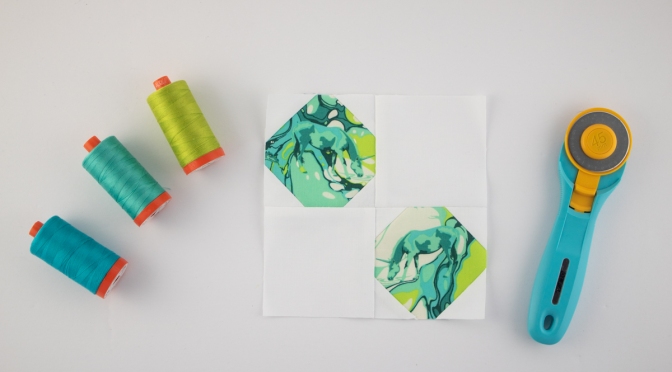
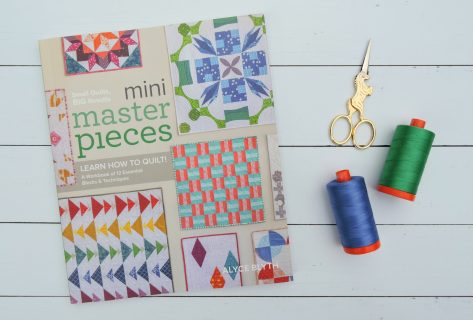

 For now, here’s the snowball block I made for today. I used some precious
For now, here’s the snowball block I made for today. I used some precious  Here’s a closer look at those swirly twirly unicorns. A subtle but fun touch, don’t you think?
Here’s a closer look at those swirly twirly unicorns. A subtle but fun touch, don’t you think?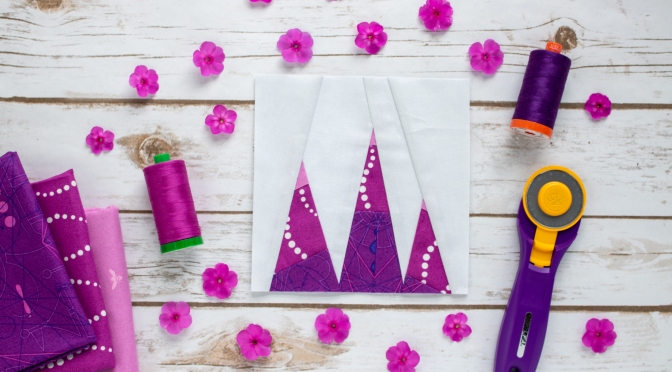
 Let’s start with this fun block! When OLFA invited me to design a block for a
Let’s start with this fun block! When OLFA invited me to design a block for a  I decided to use the purple shade and chose a small gradient of fabric in the magenta-purple fade I love so much. I chose three Alison Glass prints, which most likely comes as no surprise! The darkest purple/magenta is SunPrint 2018 Compass in Jam, the middle tone is an old one from Alison Glass SunPrint 2014 called Bike Path (I believe it was also printed as part of her Lucky Penny fabric line, so googling or Etsy searches may find some left!), and the lightest is a fabric from her Insignia 2019 fabric line. I love the way the bike path dots add fun tracks of snow down these pinnacle points! Paired with a white solid background, this block is simple and graphic and provides lots of fun for experimentation.
I decided to use the purple shade and chose a small gradient of fabric in the magenta-purple fade I love so much. I chose three Alison Glass prints, which most likely comes as no surprise! The darkest purple/magenta is SunPrint 2018 Compass in Jam, the middle tone is an old one from Alison Glass SunPrint 2014 called Bike Path (I believe it was also printed as part of her Lucky Penny fabric line, so googling or Etsy searches may find some left!), and the lightest is a fabric from her Insignia 2019 fabric line. I love the way the bike path dots add fun tracks of snow down these pinnacle points! Paired with a white solid background, this block is simple and graphic and provides lots of fun for experimentation. This block includes a fun twist to foundation paper piecing, since you premake a panel of fabric that is used to to fill each mountainous space. This means that every block you make will be slightly different, which to me equals fun! To find the instructions for this block, head over to the
This block includes a fun twist to foundation paper piecing, since you premake a panel of fabric that is used to to fill each mountainous space. This means that every block you make will be slightly different, which to me equals fun! To find the instructions for this block, head over to the  I also was honored to be asked to photograph the full OLFA 40th Anniversary quilt, where you can see how the finished Sew Along Quilt may look. Isn’t it fun!? Do you see my block?
I also was honored to be asked to photograph the full OLFA 40th Anniversary quilt, where you can see how the finished Sew Along Quilt may look. Isn’t it fun!? Do you see my block?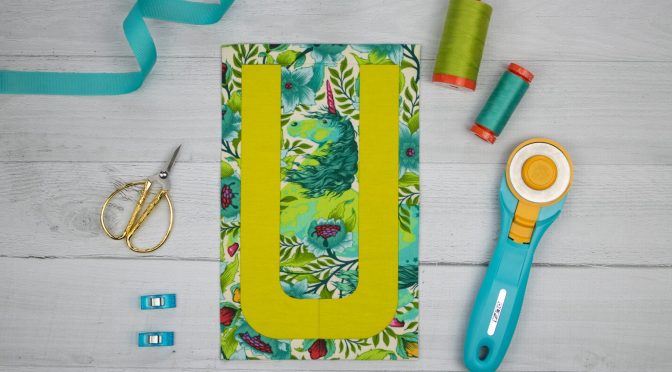
 Today I’m excited to be joining the
Today I’m excited to be joining the 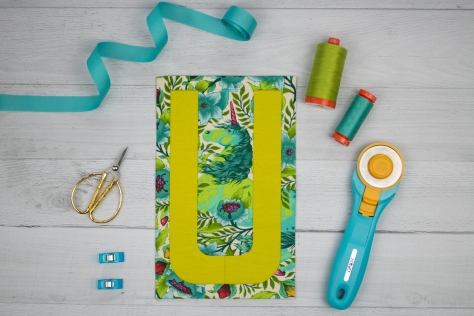 Though it’s subtle, I meticulously cut the background so that the unicorn is continuous and the fabrics all line up (mostly). The coordinating Tula Pink solid in Limeade made the perfect coordinating yet stand-out pop for the U. I used coordinating 50wt Aurifil thread to sew up my block, and between the 1231-Spring Green and 1148-Light Jade the stitches blended right in.
Though it’s subtle, I meticulously cut the background so that the unicorn is continuous and the fabrics all line up (mostly). The coordinating Tula Pink solid in Limeade made the perfect coordinating yet stand-out pop for the U. I used coordinating 50wt Aurifil thread to sew up my block, and between the 1231-Spring Green and 1148-Light Jade the stitches blended right in.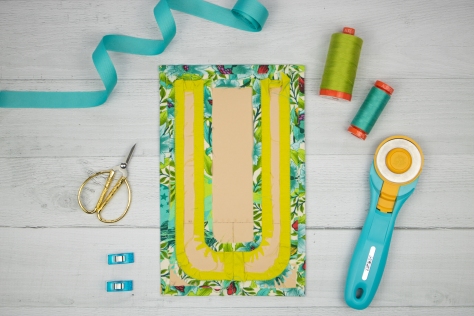 To conserve fabric with the fussy cutting, I opted to keep a few of the paper shapes together, as you can see if you inspect the backside of my letter. Can you see where there are perforations but no fabric seam? That’s where I condensed my shapes. If you’re new to EPP, basting and stitching smaller shapes may be easier, so do what’s comfortable for you.
To conserve fabric with the fussy cutting, I opted to keep a few of the paper shapes together, as you can see if you inspect the backside of my letter. Can you see where there are perforations but no fabric seam? That’s where I condensed my shapes. If you’re new to EPP, basting and stitching smaller shapes may be easier, so do what’s comfortable for you. One of the really cool aspects of these Typecast letter patterns designed by Sheri and produced by
One of the really cool aspects of these Typecast letter patterns designed by Sheri and produced by 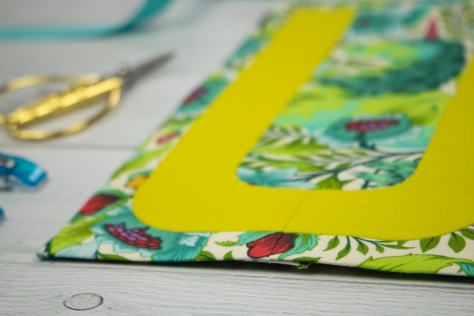 I’m pretty happy with how my fussy cutting went, and was able to give the impression that the U was just set right down on top of the continuous unicorn fabric, Frolic Imaginarium from Pinkerville by Tula Pink.
I’m pretty happy with how my fussy cutting went, and was able to give the impression that the U was just set right down on top of the continuous unicorn fabric, Frolic Imaginarium from Pinkerville by Tula Pink. I could see this U framed in a shadowbox or stitched down onto a background fabric and wrapped around a canvas in a child’s room, or of course stitched into a pillow for a Unicorn-loving friend.
I could see this U framed in a shadowbox or stitched down onto a background fabric and wrapped around a canvas in a child’s room, or of course stitched into a pillow for a Unicorn-loving friend.
 I’m excited to be joining in the fun with
I’m excited to be joining in the fun with  When I first saw Mathew’s Aura fabrics, of course I immediately dreamed of
When I first saw Mathew’s Aura fabrics, of course I immediately dreamed of  I’m so thrilled with how it turned out!! AND pillows are hard to photograph! I just solved that issue by taking lots, and hope my single monstera potted plant can help bring a bit of tropical vibe to the mid-winter Maine photos.
I’m so thrilled with how it turned out!! AND pillows are hard to photograph! I just solved that issue by taking lots, and hope my single monstera potted plant can help bring a bit of tropical vibe to the mid-winter Maine photos. Looking at the varied and gorgeous flower bundles on
Looking at the varied and gorgeous flower bundles on  They aren’t all perfect, but I’m mighty happy with the result! I also love how the blue section emphasizes the center star, while also helping blend into the Endless Paradise AGF denim background. One of my favorite aspects of the Pollen Pillow & Pollinate quilt patterns are how incredibly versatile they are.
They aren’t all perfect, but I’m mighty happy with the result! I also love how the blue section emphasizes the center star, while also helping blend into the Endless Paradise AGF denim background. One of my favorite aspects of the Pollen Pillow & Pollinate quilt patterns are how incredibly versatile they are. Here’s a look at the pillow top after it was pieced and quilted, but before it was stuffed as a pillow, so that you can see the fabric placement details a bit better. Here are the Aura fabrics I used: Laki Island Daylight for the center star and outer piehexies, Hawaiian Honu Dusk (turtles!) and Hula Dolphins Ocean (tiny dolphins circle around this one) for the star, Loulu Fans Sand for the outermost triangles, Hawaiian Honu Dusk for the turtle diamonds around the outside edge, and AGF Denim in Endless Paradise for the accent pieces in the outer piehexies and the background. I LOVE the fabric names, too!
Here’s a look at the pillow top after it was pieced and quilted, but before it was stuffed as a pillow, so that you can see the fabric placement details a bit better. Here are the Aura fabrics I used: Laki Island Daylight for the center star and outer piehexies, Hawaiian Honu Dusk (turtles!) and Hula Dolphins Ocean (tiny dolphins circle around this one) for the star, Loulu Fans Sand for the outermost triangles, Hawaiian Honu Dusk for the turtle diamonds around the outside edge, and AGF Denim in Endless Paradise for the accent pieces in the outer piehexies and the background. I LOVE the fabric names, too! I used coordinating 50wt thread to hand stitch the full Pollen Pillow design, stitching during travel to QuiltCon, in cafes, or in the car while waiting for preschool pickup. I adore the portability of English Paper Piecing (EPP)! When the Pollen Pillow design was fully stitched, pressed, papers removed, etc., I then stitched it to the backing using 50wt thread in 2000-Light Sand and 1320-Bright Teal. I quilted the pillow with some minimal quilting to secure the pieces while still letting the fabrics shine. I quilted a fun geometric echoey pattern in the background using the walking foot on my Bernina 560, and making it up as I went along. I love using the wide width of my walking foot as a gauge when quilting, since I avoid marking fabrics whenever possible!
I used coordinating 50wt thread to hand stitch the full Pollen Pillow design, stitching during travel to QuiltCon, in cafes, or in the car while waiting for preschool pickup. I adore the portability of English Paper Piecing (EPP)! When the Pollen Pillow design was fully stitched, pressed, papers removed, etc., I then stitched it to the backing using 50wt thread in 2000-Light Sand and 1320-Bright Teal. I quilted the pillow with some minimal quilting to secure the pieces while still letting the fabrics shine. I quilted a fun geometric echoey pattern in the background using the walking foot on my Bernina 560, and making it up as I went along. I love using the wide width of my walking foot as a gauge when quilting, since I avoid marking fabrics whenever possible!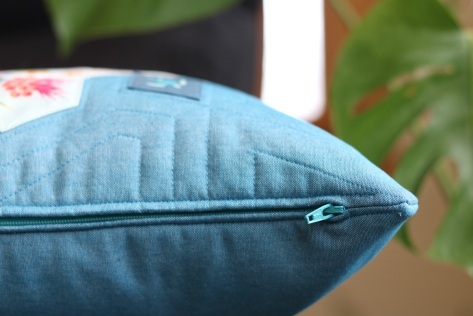 Even having made multiple pillows, the insertion of a zipper still gives me the willies a bit before diving in. This time I used
Even having made multiple pillows, the insertion of a zipper still gives me the willies a bit before diving in. This time I used  Those of you familiar with my
Those of you familiar with my  Here are just a couple more photos to round out this post. The first is of my daughter Maddie, who really wanted to be a pillow holding model (so helpful!). You can see the most pattern details in this photo, I think, so I’m glad she wanted to help!
Here are just a couple more photos to round out this post. The first is of my daughter Maddie, who really wanted to be a pillow holding model (so helpful!). You can see the most pattern details in this photo, I think, so I’m glad she wanted to help! Finally, here is a photo of my original Pollen Pillow duking it out with this newbie for the prime spot. It’s so fun to see both of these pillows next to each other, since it’s a perfect example of how different fabric choices and color placement can result in very unique aesthetics with the Pollen Pillow pattern.
Finally, here is a photo of my original Pollen Pillow duking it out with this newbie for the prime spot. It’s so fun to see both of these pillows next to each other, since it’s a perfect example of how different fabric choices and color placement can result in very unique aesthetics with the Pollen Pillow pattern.

 The pattern includes foundation templates for the 16 blocks shown on the cover, plus assembly instructions for putting them all together into a mini mini sampler that finishes at a whopping 7 1/2″ square. Each block measures 1 1/4″ square finished, and 1 3/4″ unfinished. The pattern includes tips on tiny piecing in general, links to resources on
The pattern includes foundation templates for the 16 blocks shown on the cover, plus assembly instructions for putting them all together into a mini mini sampler that finishes at a whopping 7 1/2″ square. Each block measures 1 1/4″ square finished, and 1 3/4″ unfinished. The pattern includes tips on tiny piecing in general, links to resources on 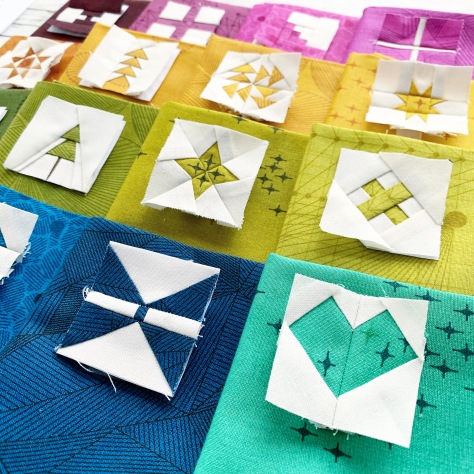 I had fun playing with
I had fun playing with 
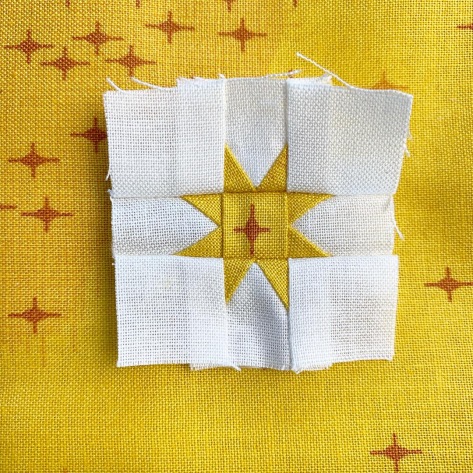
 I highly recommend reading my
I highly recommend reading my 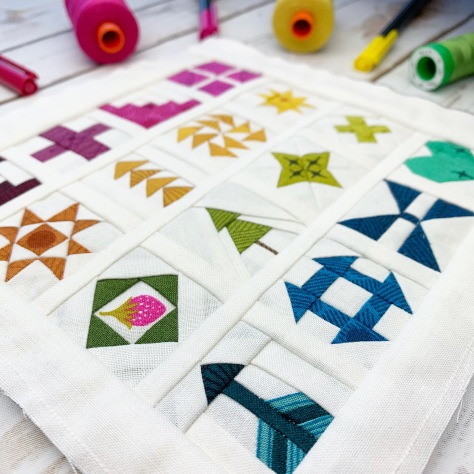 Head over and get your
Head over and get your 
 Today I’m excited to reveal the block I designed for the
Today I’m excited to reveal the block I designed for the  Today I am going to share 3 tips for using fussy cutting in foundation paper pieced blocks, using my Adventure Abounds block from the Splendid Sampler 2 book. If you’re new to foundation paper piecing (FPP), read my
Today I am going to share 3 tips for using fussy cutting in foundation paper pieced blocks, using my Adventure Abounds block from the Splendid Sampler 2 book. If you’re new to foundation paper piecing (FPP), read my  There are a few things you should remember before beginning FPP: First, the templates are a mirror image of the finished block, so when planning your fabric placement, visualize the right side of your fabric on the back of the template. Second, I highly recommend color coding your paper templates before starting so that you know exactly where each fabric should be. Third, don’t forget to use paper scissors to cut out and trim the templates! Your fabric scissors don’t want to go there!
There are a few things you should remember before beginning FPP: First, the templates are a mirror image of the finished block, so when planning your fabric placement, visualize the right side of your fabric on the back of the template. Second, I highly recommend color coding your paper templates before starting so that you know exactly where each fabric should be. Third, don’t forget to use paper scissors to cut out and trim the templates! Your fabric scissors don’t want to go there! Once your fabrics are selected, your templates are cut out along the 1/4″ seam allowance line and color coded, you’re ready to dive in. Here are three tips for using fussy cutting in FPP:
Once your fabrics are selected, your templates are cut out along the 1/4″ seam allowance line and color coded, you’re ready to dive in. Here are three tips for using fussy cutting in FPP: As an example of this for my Adventure Abounds block, I decided to position a subtle bird in the sky above the ocean, and held it up to a window to make sure it was positioned exactly how I wanted it. With a white on white background for my blocks, this example is subtle, but sometimes those subtle details are my favorite!
As an example of this for my Adventure Abounds block, I decided to position a subtle bird in the sky above the ocean, and held it up to a window to make sure it was positioned exactly how I wanted it. With a white on white background for my blocks, this example is subtle, but sometimes those subtle details are my favorite! To create a template, first trace the shape from the paper foundation template onto the plastic. Be sure to label your piece, AND make note of directionality since the paper template is a mirror image.
To create a template, first trace the shape from the paper foundation template onto the plastic. Be sure to label your piece, AND make note of directionality since the paper template is a mirror image. Once I trace the shape, I flip over the template plastic and write my notes on the opposite side, so that when I cut the fabric for that piece, I know that my notes should be legible on the right side of the fabric.
Once I trace the shape, I flip over the template plastic and write my notes on the opposite side, so that when I cut the fabric for that piece, I know that my notes should be legible on the right side of the fabric. Next, using a quilting ruler with 1/4″ measure, draw seam lines 1/4″ outside all the edges of your drawn lines.
Next, using a quilting ruler with 1/4″ measure, draw seam lines 1/4″ outside all the edges of your drawn lines. Cut out the template along that seam allowance line.
Cut out the template along that seam allowance line. For my block, I decided to fussy cut the heart so that the fabrics for the two pieces of the heart look continuous despite consisting of two fabric pieces. I decided to make a third reference template of the full heart and traced the pattern from the fabric onto the template, which I used as a reference when cutting out each individual part.
For my block, I decided to fussy cut the heart so that the fabrics for the two pieces of the heart look continuous despite consisting of two fabric pieces. I decided to make a third reference template of the full heart and traced the pattern from the fabric onto the template, which I used as a reference when cutting out each individual part. Once you have your template positioned over the exact motif you want, carefully trace around the template with a fabric marking tool and cut out the fabric, or very carefully use a rotary cutter to cut around the template. Note that with planning templates made with template plastic or repurposed food lids, using your rotary cutter contains a good level of danger–so either purposefully live on the wild side, or use the trace and cut-with-scissors method!
Once you have your template positioned over the exact motif you want, carefully trace around the template with a fabric marking tool and cut out the fabric, or very carefully use a rotary cutter to cut around the template. Note that with planning templates made with template plastic or repurposed food lids, using your rotary cutter contains a good level of danger–so either purposefully live on the wild side, or use the trace and cut-with-scissors method! Your perfectly planned fabric piece is ready to carefully stitch onto your growing foundation paper pieced section.
Your perfectly planned fabric piece is ready to carefully stitch onto your growing foundation paper pieced section.
 Folding along the seam on which you are about to stitch and trimming the overhanging fabric to 1/4″ will help you line up the next piece accurately.
Folding along the seam on which you are about to stitch and trimming the overhanging fabric to 1/4″ will help you line up the next piece accurately. You can also fold over the piece you are about to stitch along the seam line to see how it looks before actually stitching.
You can also fold over the piece you are about to stitch along the seam line to see how it looks before actually stitching. Once your fussy cut pieces are cut and stitched as desired, continue piecing your non-fussy cut pieces as you would any other FPP block.
Once your fussy cut pieces are cut and stitched as desired, continue piecing your non-fussy cut pieces as you would any other FPP block. In the Adventure Abounds block I made for the original Splendid Sampler 2 quilt, I used this tip when piecing the text on the tree, specifically the word “love”, since the word “listen” was the first piece placed, and was therefore easy to simply glue in place and piece around. Knowing that I wanted the top of the word love to be juuust below that darker top piece, when I cut the square of fabric I carefully cut just a tad bit more than 1/4″ from that top edge of the word love. I left the rest of the rectangle of fabric a bit larger and less specific, since as long as that edge lined up properly, the rest didn’t matter.
In the Adventure Abounds block I made for the original Splendid Sampler 2 quilt, I used this tip when piecing the text on the tree, specifically the word “love”, since the word “listen” was the first piece placed, and was therefore easy to simply glue in place and piece around. Knowing that I wanted the top of the word love to be juuust below that darker top piece, when I cut the square of fabric I carefully cut just a tad bit more than 1/4″ from that top edge of the word love. I left the rest of the rectangle of fabric a bit larger and less specific, since as long as that edge lined up properly, the rest didn’t matter. Whenever employing any type of meticulous cutting in your FPP, it’s always a good idea to trim your 1/4″ seam allowance before positioning and stitching your fussy cut shape. To do this, simply fold back the foundation paper along the line you are about to sew on, and using a quilting ruler with 1/4″ measure, trim the fabric 1/4″ away from the fold. (Obviously use a cutting mat underneath! This photo shows without the mat for aesthetic consistency). Once your fabric is trimmed, you have a clean line with which to line up your next meticulously placed piece.
Whenever employing any type of meticulous cutting in your FPP, it’s always a good idea to trim your 1/4″ seam allowance before positioning and stitching your fussy cut shape. To do this, simply fold back the foundation paper along the line you are about to sew on, and using a quilting ruler with 1/4″ measure, trim the fabric 1/4″ away from the fold. (Obviously use a cutting mat underneath! This photo shows without the mat for aesthetic consistency). Once your fabric is trimmed, you have a clean line with which to line up your next meticulously placed piece. When your paper is folded along the seam-to-be-sewn, you can place it on your next fabric (right side up) and the paper shape as folded will be exactly on top of the fabric that will end up in that space once you sew along the line. Be sure to visit
When your paper is folded along the seam-to-be-sewn, you can place it on your next fabric (right side up) and the paper shape as folded will be exactly on top of the fabric that will end up in that space once you sew along the line. Be sure to visit  What that means for us is that with that clear 1/4″ seam line showing us the direction we want our print to go, simply lining up the folded seam line with the directional print will ensure the pattern runs in exactly the direction we want. Fold up the edge a bit to peek under and make sure the pattern is positioned the way you want it, then without changing the position of the fabric, fold the paper back up and sew along the line.
What that means for us is that with that clear 1/4″ seam line showing us the direction we want our print to go, simply lining up the folded seam line with the directional print will ensure the pattern runs in exactly the direction we want. Fold up the edge a bit to peek under and make sure the pattern is positioned the way you want it, then without changing the position of the fabric, fold the paper back up and sew along the line. You will end up with your directional fabric meticulously positioned along the seam line, just how you wanted it. Paired with that fun bird flying over the ocean that we placed using Tip 1, these tips can help take your foundation paper piecing blocks to a whole new, intentional level.
You will end up with your directional fabric meticulously positioned along the seam line, just how you wanted it. Paired with that fun bird flying over the ocean that we placed using Tip 1, these tips can help take your foundation paper piecing blocks to a whole new, intentional level. Okay, just one peek at my planned layout and a few of my blocks so far. A full look will come in its own blog post soon, so be sure to follow this space!
Okay, just one peek at my planned layout and a few of my blocks so far. A full look will come in its own blog post soon, so be sure to follow this space!